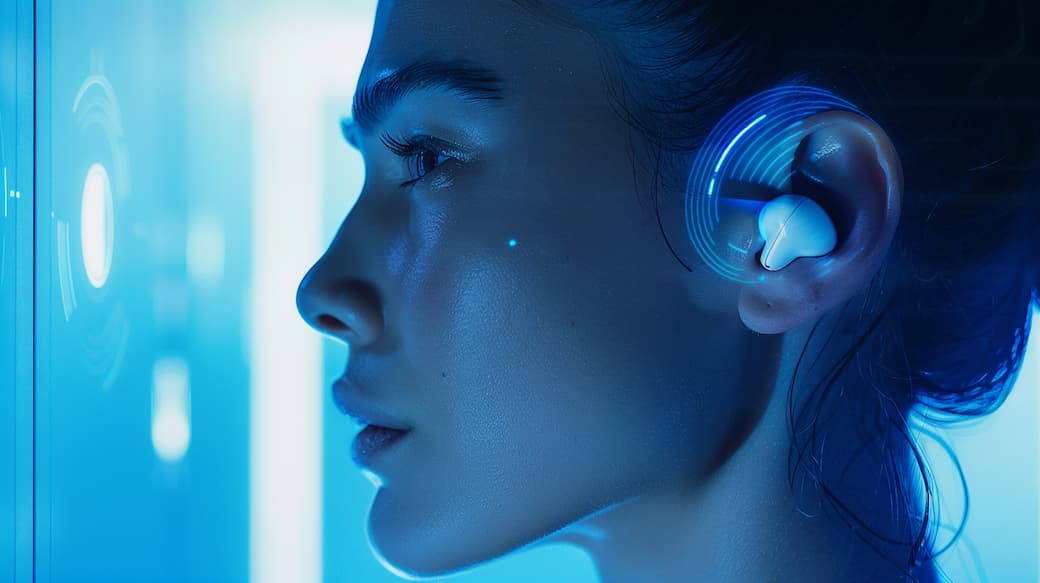
3D Audio Earbuds: Future Headphones with next-gen tech?!
Content
Introduction: The Evolution of Spatial Audio Earbuds
Spatial audio has evolved from basic surround sound to advanced spatial audio earbuds that adapt in real-time. Unlike stereo, spatial sound creates a three-dimensional sense of space, making audio feel more natural and immersive. Finally making use of what our two ears are capable of.
Recent developments in wireless earbuds, head tracking, and personalized spatial audio allow for more realistic sound placement, adjusting dynamically to head and ears’ movements. “Brands” like Dolby Atmos have expanded spatial audio work beyond movies and music into gaming.
Moreover, while not as obvious yet, AI is expected to influence the audio sector significantly. Theories suggest that AI could enhance how spatial audio works by optimizing sound placement and adapting to user environments in real-time, potentially revolutionizing the way we experience sound.
Adoption and Consumer Experience
Major brands like Apple, Sony, and Samsung are integrating spatial audio into their devices, but user experiences vary. While iOS offers seamless head tracking and Dolby support, compatibility across apps, TVs, headphones, and gaming systems is inconsistent. So there is room for companies like Ceva to create products and new features for the market.
For spatial audio earbuds to reach full potential, technology must improve in:
- Content adaptation – Making more devices compatible with spatial sound.
- Real-time processing – sound adjustments such as spatialization and head-tracking
- User control – Allowing to fine-tune spatial audio settings.
As demand for immersion grows, spatial audio is becoming a standard in modern audio work, shaping how we listen, communicate, and interact with digital environments. This extends the analysis from Article 1, where we examined the distinctions between various spatial audio systems.
Find out more about the cool stuff Ceva is doing on spatial audioCustomization in Spatial Audio: More than Just HRTF
Personalization & Flexibility
Customization is crucial to enhancing the spatial audio experience. Traditional HRTF (Head-Related Transfer Function) models offer a generic calculation to simulate 3D sound, but they don’t account for everyone’s unique hearing profiles.
This limitation led Apple to introduce personalized HRTF for their spatial audio earbuds, which became mainstream as iPhone users could take images of their ears to improve their listening experience. However, this is just one direction in which spatial audio processing could evolve in the future with just limited user control that could be even more user friendly.
Challenges in Flexibility of Surround Sound
Achieving a universal solution that works seamlessly across various devices and environments remains a significant challenge. Traditional personalization methods, such as HRTF, focus primarily on adjusting how sound is perceived in space, but they are often difficult to customize, especially when it comes to non-technical users.
Elements like room size, reverb levels, timbre (the quality of sound), and localization (the perceived direction of sound) should be flexible and easily adjustable.

However, I think the future of spatial audio lies in making these customizations accessible to everyone, without the need for complicated setups or knowledge of technical audio terms. Listeners should be able to effortlessly fine-tune their experience based on personal preference. Whether a user prefers a more immersive soundstage with precise localization or a smoother, less sharp timbre, the technology should make these adjustments intuitive and user-friendly.
This approach is crucial to ensure that spatial audio isn’t just limited to audiophiles and tech experts, nor confined to a one-size-fits-all solution. By offering an easy-to-personalize system, manufacturers can ensure that all users, regardless of their audio expertise, can enjoy a high-quality, tailored listening experience.
The Karaoke Feature: User Control in Non-Spatial Audio
A relevant example outside of spatial audio is Apple Music’s karaoke function. This feature lets users control vocal levels, providing a customizable listening experience.
A similar approach could be applied to spatial audio work, where listeners choose the degree of localization, depth, or reverb they prefer. This is what object-based audio is capable of – being more than about placing sounds in 3d space, but testing what sound you like best.
Another use-case is MPEG-H, which allows users to customize audio elements, offering more control over the enabled content. If spatial audio followed this model, it could provide more adaptability, ensuring that sound is tailored to individual preferences rather than a pre-defined setting that Dolby tries to control.
Content is Still King – But Could AI Become Queen?
Many consumers still struggle to understand what spatial audio truly offers, largely due to unclear terminology. Terms like “Spatial Audio,” “3D Audio,” and “Room Sound” are often used interchangeably, leading to confusion. Additionally, platforms fail to highlight what audio format is being played. For instance video streaming platforms, clearly mark video resolutions like Full-HD and 4K, those platforms don’t speak the same language as the adopter sound wise.

- YouTube provides no clear labels for stereo vs. ambisonics (for 360 videos). Even when using new formats like Eclipsa Audio, you are currently never sure what you are really listening to and if it’s working.
- Apple Music at least marks “Dolby Atmos,” but since Atmos tracks are often played back way louder, laymen may assume they sound superior when that is not necessarily the case.
- XR Industry: Even in the VR space, where 3D audio should be a core feature to match the 3D visuals, many hardware manufacturers make misleading claims about “immersive audio” without truly delivering on that promise
These are just a few examples, but they highlight a broader issue: manufacturers and platform providers are responsible for educating potential buyers and providing proper support.
Even for experts like myself, it can be difficult to determine what technology is being used and how to troubleshoot when something doesn’t work as expected. If spatial audio is to reach mass adoption, companies must do a better job at transparency, education, and guidance – I’m here to help 😉
Ecosystem Limitations for virtual surround sound
The quality of multichannel spatial audio depends heavily on the content it’s paired with. While formats like Dolby Atmos Music try to offer an immersive experience, the quality of these mixes can vary significantly.
Most mixes were initially created for loudspeakers rather than headphones, resulting in a final product that sometimes feels like a leftover adaptation. This discrepancy means that some users may not fully experience “true” spatial audio as intended, relying instead on up-mixed or simulated versions that don’t always capture the full potential of 3d audio.
Head-Tracking: A Powerful Technology, But Context Matters
Head-tracking is one of my favorite features that enhances the spatial audio experience, allowing for more natural feeling as the user moves their head. It helps solve the problem of front-back confusion and can create a more immersive experience, especially for content like 360° videos or VR, where accurate sound positioning is key.
However, the effectiveness of head-tracking depends on both the content and the system supporting it. While Dolby Atmos, for example, can be listened to with or without head-tracking, not all content is mixed with this feature in mind.
Multi-channel audio may not benefit from head-tracking the way immersive video content does. For 360° videos, head-tracking is essential to avoid disorienting the listener, especially in the absence of visual cues.
This is where Ceva’s approach stands out. Ceva has a tightly integrated solution that combines rendering and head-tracking, with a focus on use-case-dependent recentering behavior. Their deep expertise in sensor fusion provides a competitive edge, ensuring that head-tracking adapts intelligently to different content types and listening environments.
AI’s Role in Content Processing
AI has the potential to enhance spatial audio by intelligently mixing and adapting content better and faster than humans. If AI can analyze a stereo mix, it could dynamically adjust sound positioning, reverb, and depth, making standard audio more immersive. Upmixing algorithms in cars already create stunning spatial experiences out of a two-channel stereo file.
Upmixers are improving rapidly, and in the future, we might not need Dolby Atmos content at all. AI could do a better job than audio engineers who are often constrained by time and budget. The idea of having a version of a song that improves over time is for me more exciting to me than being limited by the best mix possible at the time of release. Ceva’s current embedded upmixing algorithm is an exciting first step on this path.
Click to find out how Ceva enables efficient audio, voice and sensor tech in embedded systemsBeyond Entertainment: The Future of Spatial Audio
When people think of spatial audio, they mostly associate it with entertainment— watch movies, music, and gaming. Marketing reinforces this focus, emphasizing the immersive experience as a way to make content more engaging.
But I’m convinced spatial audio has far more practical applications that go beyond just fun—it can actively enhance how we communicate and interact in everyday life.
Communication Applications beyond Dolby Atmos
By simulating voices coming from several speakers in different locations in a virtual space, spatial audio improves video calls and voice chats. This helps distinguish multiple speakers, making conversations feel more natural, reducing cognitive load which is scientifically proven – making discussions clearer and less fatiguing for listeners.
With spatial audio being integrated into communication platforms and healthcare devices, its impact extends beyond entertainment. As more devices, software and apps adopt this technology, it could become a standard feature in everyday work, making people understand the benefits of spatial audio earbuds.

Assistive Hearing Technologies
One of the most promising applications of future headphones is in assistive hearing devices. By improving sound separation and clarity, such devices can help individuals better understand speech, even in noisy environments. The ability to customize audio processing based on individual hearing profiles could make these devices even more effective. Additionally, reducing fatigue and enhancing clarity through AI-driven sound adjustments could make users more inclined to wear these devices for longer periods.
A notable advancement in this area is Ceva’s multi-sensor ENC (Environmental Noise Cancellation). Traditional ENC technology focuses on preserving human speech, but struggles with background conversation since it doesn’t distinguish between the wearer’s voice and other voices in the environment.
Ceva is working on a novel method to improve voice intelligibility during calls by enhancing the wearer’s voice while reducing background noise, without the need for expensive additional hardware. By leveraging advanced sensor technology, this innovation enhances call clarity and overall user experience, even in noisy environments.
Samsung has also made significant progress in this area by incorporating real-time translation technology into its headphones when paired with Android devices, improving communication in multilingual environments.
Additionally, Samsung’s 360 Audio feature is promising, providing an immersive experience. However, it ultimately resembles regular audio, and especially with the demo video it remains unclear who this feature truly appeals to outside of audiophiles like myself.
It’s also worth mentioning Apple’s assistive hearing features, which, although not spatialized, are the first to offer such capabilities. This is a significant step to transforming earbuds into hearables.
Apple Patents and the Rise of “Hearables”
Future headphones won’t just be about playing sound — they will be multi-functional hearables (wearable + hearing). Apple has filed patents for AirPods with built-in biosensors capable of tracking brain activity (EEG), biometric sensors (body temperature, heart rate) or even IR cameras (potentially for spatial computing, AR, VR applications for situational appropriateness). These features that can directly improve the spatial experience suggest a future where wireless earbuds are not only audio devices but also health and fitness monitors.
Conclusion & Future Outlook: The Path Forward for Spatial Audio
On the technical side, spatial audio will continue to evolve, offering more immersive and intelligent soundscapes. Key areas of innovation include:
-
Reverb & Room Modeling: More precise simulation of acoustic environments for a natural listening experience adapting to content and use-case with dynamic head-tracking
-
AI-Driven Audio Processing: Smart algorithms that adapt to the listener’s surroundings, optimizing audio output dynamically.
-
Improved Localization & Customization: More precise placement of sound sources and user-controlled adjustments for a tailored experience.
Ultimately, spatial audio’s future lies not just in better sound quality, but in smarter, more adaptive, and more interactive audio systems that cater to individual needs.

Technical Advancements & Missed Potential
From a technological perspective, spatial audio already has many impressive capabilities. Improvements allow for highly adaptive, real-time experiences. However, despite these advancements, there is a sense that the industry is losing potential at every step.
On the other hand, spatial audio content must improve in storytelling, professional mixing, and investment to fully realize its potential.
While companies, such as Apple, followed by Google and Samsung, have made significant strides, we’re not yet at the point where spatial audio feels truly seamless for mass adoption. The first touchpoints consumers have had with spatial audio have often been underwhelming or inconsistent, which makes it harder to foster lasting excitement. Someone had to be first in pushing this technology, but the way it has been introduced has not always made the best first impression.
Internet trends like 8D audio, or the “virtual barbershop” on YouTube demonstrate that people are genuinely excited about spatial audio and are eager for more immersive experiences. While some of these, like the barbershop, only utilize simple sound recordings or specialized techniques like the rotating 8D audio, they still showcase the potential of spatial audio, hinting at how much better it could be when applied to more sophisticated content and future spatial audio earbuds.
Spatial audio is expanding beyond entertainment into communication, accessibility, and health applications. While immersive sound in games or movies creates emotional impact, solving real-world problems—like improving voice communication or supporting assistive hearing—may ultimately be the bigger driver of mass adoption. These use cases deliver immediate, practical value that users can feel in their daily lives.
Independent software providers like Ceva can play a key role by giving OEMs the tools to build personalized audio experiences, develop distinctive sound signatures, and ensure seamless spatial playback across devices—whether phones, PCs, TVs, or smartwatches. These capabilities go beyond flashy demos and lay the foundation for a more intuitive and human-centered audio future.
To succeed, the industry must pair technical innovation with transparency, education, and better first-touch experiences. Also there needs to be more support for those who are interested in understanding and utilizing spatial audio effectively.That’s what will truly open the ears of the mainstream.
Disclaimer:
This article was created in collaboration with Ceva. The content reflects both my independent opinion and the perspectives developed through my partnership with Ceva. Despite the partnership, the analysis and evaluation of the technologies are based on my professional assessment.
Are you working on spatial audio tech, content, or implementation? Let’s collaborate—reach out if you’re interested in pushing this industry forward!
Back to the BlogRelated Articles
Which Spatial Audio Earbuds sound best? A Competitive Analysis
Concert With Headphones: Silent Disco - A New Dimension for Live Events with 3D Audio
Dolby Headphone: Dolby Atmos Headphones with Spatial Audio Have This Problem
Dynamic Head Tracking - Spatial Audio for 3D Surround Headphones
Spatial 3D Audio Apps - Apple Airpods Pro, Galaxy Buds Head tracking